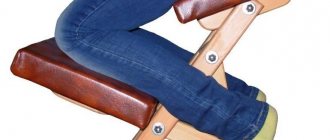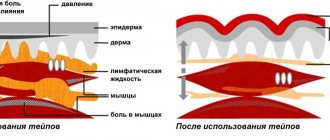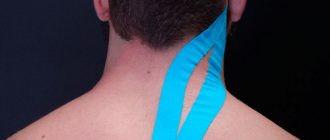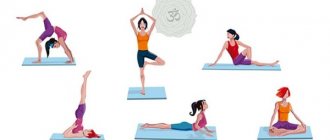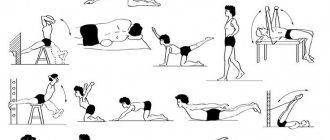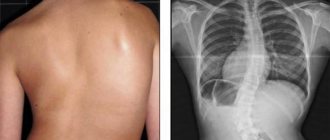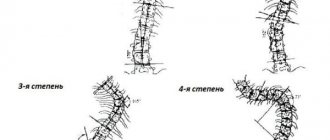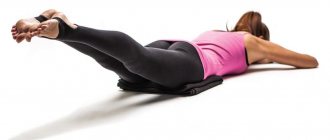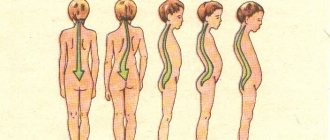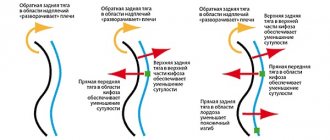Slouching is a worrying sign. This is a signal about possible problems in the functioning of the body. Incorrect posture leads to dysfunction of internal organs, the nervous system and diseases of the spine. Kinesio taping helps restore correct posture for both adults and children. Kinesio tapes show high effectiveness not only for the prevention of stooping, but also in the treatment of scoliosis.
Taping is a technique developed by an American physiotherapist in the late 70s. Dr. Kenzo Kase sought to speed up the healing of injured patients by applying adhesive elastic bands to the body according to special patterns. Thanks to impressive results, the technique has become widespread in both medical and sports environments.
A thermoactive polymer adhesive is applied to the surface of the tape, so the tapes stay on the skin for up to 5 days. The adhesive layer does not dissolve upon contact with sweat or water. The application does not limit the range of your activities: exercises, showers, swimming in the pool do not provoke peeling of the tapes.
Taping for scoliosis
Scoliosis is a disease that can affect the spine at any age. Deformities occur in both newborns and adults. In this case, the spinal column bends and twists, which leads to serious health problems. To restore correct posture in patients, doctors use both surgical treatment and non-surgical methods of therapy. Taping for scoliosis is used as an auxiliary technique not only in the postoperative period, but also in combination with massage, exercises and corsetry.
Application of kinesio taping of the spine for scoliosis
- relieves hypertonicity of the back muscles;
- increases freedom of movement;
- reduces pain;
- accelerates the recovery period;
- stimulates metabolic processes in tissues;
- strengthens the muscle corset.
Working method
Kinesio tapes BBTape (“Bio Balance Tape”) (Korea) were used in the work Initially, the technical implementation of the kinesiotaping method was carried out not only according to classical theoretical approaches, but often the main task was to eliminate the pain syndrome during bracing using the Chenault method, and not to treat the underlying disease with taping. Taping was carried out in a course depending on the duration of the patient’s hospitalization, or a period of 1 month was taken for applying taping, with an interval between application of tapes of 4-7 days. We will focus on the fact that many patients did not use repeated taping after 4 days [7, 9], since even 1 taping session per week was enough to provide a pronounced one or another expected result.
Taping for scoliosis in children
The child’s body quickly changes, so treatment for scoliosis should begin as early as possible. This way there is a greater chance of avoiding surgery and unnecessary stress. If scoliosis is at an early stage and the child receives treatment prescribed by a doctor, taping for scoliosis in children is additionally used to enhance the effectiveness of special exercises. For this purpose, a prophylactic application is used. It gently corrects posture and is suitable for both calm and active children.
- Measure 2 pieces of standard kinesio tape 2 cm wide and length from the shoulder joint to the child's fingertips.
- Round the corners at the ends of the bands to improve grip.
- Prepare the skin of your hands for application by degreasing it with an alcohol wipe.
- On your outstretched arm, with the inner side facing you, begin to apply the tape without tension, moving in a spiral in an outward direction.
- Rub the surface of the patch to activate the adhesive. Repeat on the other hand.
This application, due to irritation of the skin at the sensory level, stimulates the reflexive unfolding of the arms and bringing the shoulder blades together. This works as a preventative against slouching and also involves the rhomboid and trapezius muscles in maintaining proper posture.
Kinesio taping for children
Kinesio tape is applied to an injured or diseased area of the body and left there for a while. This usually lasts from 3 to 5 days; in some cases, a patch with reinforced adhesive is used, which can last a whole week. The tape is coated with a special hypoallergenic acrylic adhesive that begins to work upon contact with the skin. The glue does not cause allergic reactions and does not leave marks on the skin, and has no unpleasant odor.
In the process of applying kinesio tapes to a damaged muscle or joint, different tensions of the tape are used, which improves blood circulation and models the muscle-fascial segment. Therefore, kinesio taping, and especially in combination with other methods of treating injuries, has a simply amazing effect:
- reduces pain;
- relieves swelling in the damaged area;
- promotes localization of the inflammatory process and, subsequently, its complete elimination;
- takes on part of the load placed on the damaged muscle or joint.
A correctly applied patch has a therapeutic effect on the patient within 20 minutes after application. In addition, it does not exclude the possibility of combination with other types of treatment, for example, with exercise or physiotherapy.
Other advantages of applying kinesio tapes include:
- the patch is very elastic and does not cause discomfort;
- the tape is made of cotton, your skin will fully “breathe”;
- the material is waterproof, you can shower without fear;
- Kinesio tape holds tightly to the application site.
So, the child comes to class with kinesio tapes already applied in advance, which help correct the position of the ligaments, relax or stimulate the muscles. This is why it becomes much easier for children to practice, and the necessary results are achieved much faster than in the case of using standard treatment methods.
Below are some conditions for which taping is most effective:
- various pathologies and injuries of the musculoskeletal system;
- cerebral palsy;
- deformation processes in the feet and lower extremities;
- cicatricial changes on the skin;
- swelling and lymphodema.
Sometimes it can be very difficult to force a child to take pills or apply ointment with a strong, unpleasant odor. In the case of applying kinesio tapes, everything is much simpler - the patch does not cause any discomfort in the child. In addition, tape manufacturers produce products in a variety of colors and designs, which children love so much.
Kinesio taping is completely safe for children’s health, because the tapes do not contain any medications.
Taping for scoliosis in adults
Scoliosis is uncommon in adulthood. This is either a curvature of the spinal column that was not fully cured in childhood, or an acquired problem. Diagnosing scoliosis in an adult is not easy, because many do not pay attention to painful sensations in the back, attributing them to fatigue.
It is possible to understand that you have problems with the spine after palpating the back muscles. Hypertonicity is a clear sign of curvature. A simple application used for taping for scoliosis in adults will help relieve spasm and maintain posture in the correct position.
- Prepare 2 pieces of tape 5 cm wide and 30 cm long, round the edges.
- Release the 5 cm long edge of the tape (anchor) and apply it without tension in the area of muscle hypertonicity. Glue the remaining piece of tape with a tension of 50%.
- Apply the tape on the opposite side of the spine without tension.
The result is a symmetrical application of two parallel strips of kinesio tape. It equally effectively relieves muscle hypertonicity and stiffness of movement in both lumbar and thoracic scoliosis.
Functions of kinesio taping
There is a misconception in society that the introduction of tapes ( tape is a term originating from various words in other languages: Tape (from the English tape “strip, tape”) - in sports medicine, an adhesive tape made of fabric, reminiscent of an adhesive plaster, used
) doesn't make any sense.
They do not cure the disease. Indeed, patches and tapes are not able to cure the same hernia of the spine. You can cope with the disease with the help of special exercises and specific pharmaceuticals. But at the initial stages of the disease, the use of kinesiotaping allows you to avoid the use of powerful products, reduce the intensity of pain and restore the functions of the spine ( the load-bearing element of the skeleton of vertebrate animals (including the human skeleton)
).
The main function of the tape is to support the muscles and tendons of the spine. It relieves overload from the spinal column, due to which the tissues are restored even faster, the risk of complications is reduced and the nerve is not pinched. This means that the healing rate is increased.
Kinesio taping must be carried out in courses. The number of courses is described by the treating doctor. The 1st course lasts from 3 to 5 days. The duration of the next courses is determined by the treating doctor based on the results of therapy. Healing with therapeutic strips stops after the patient's pain goes away.
Taping schemes
Kinesio taping for scoliosis makes treatment less painful, speeds up rehabilitation and supports muscles around the clock. The use of tapes is available not only to doctors and athletes. To apply the application correctly, a basic knowledge of the structure of the musculoskeletal skeleton and the basics of kinesio taping is sufficient. The schemes developed by experts are presented in specialized literature. For example, in the book “Basics of Kinesiological Taping” by V. Gait, dozens of applications are described and illustrated in detail.
A number of rules have been adopted for their implementation:
- Before applying kinesio tape, prepare the taping area by removing any remaining ointments and degreasing the skin with an alcohol wipe.
- Palpate the back muscles to determine which side of the spinal column has hypertonicity.
- Apply the applique, following the instructions for the selected pattern.
- Remove tapes while holding the skin to avoid injury.
Features of treatment of different types of curvature
The science of anatomy determines that in its normal state the spinal column has an S-shaped curve. Otherwise, if it were level, a person would not be able to move, sit, or make other movements. Certain unfavorable factors can cause deviations in the bending value, thereby causing a certain disease:
- anterior curvature is kyphosis;
- posterior curvature is lordosis;
- sideways curvature is scoliosis.
In each case, to get rid of the disease, it will be necessary to engage in special physical exercises, massage, and in some cases, wear corrective devices. Physiotherapy is also used (for example, it can be manual or reflexology), as well as swimming. In severe cases, surgery is required.
Contraindications
The use of tapes for scoliosis is indicated at any age. This is an effective and safe method for health. But there are also contraindications for using applications:
- skin prone to injury;
- diseases of the cardiovascular system;
- increased sensitivity to tape components.
To get the maximum benefit from taping, consult your doctor before the procedure.
Which tapes should you choose?
Names of the best brands and cost of tapes:
- Ares. Kinesiology tape helps reduce pain, restores joint mobility, and improves blood and lymph circulation. Price – 810 rub.
- Bb tape. Thanks to the special fiber structure, the tape allows air to pass through, allowing the skin to breathe. It is elastic and wicks away moisture. The therapeutic effect lasts for 5-7 days. Price – 960 rub.
- Intrarich. The adhesive composition is acrylic, hypoallergenic. The adhesive surface is moiré. The tape is air and waterproof. Freedom of movement is not limited. Price – 715 rub.
- Kinesio. Provides nanosensory stimulation of the epidermis and lower layers of skin. Thanks to the reinforced weave of fibers, wearing the tape ensures comfort. Price – 1200 rub.
You need to buy products at specialized sales points. Upon request, sellers must provide all product documents.
Patient reviews
Arina . I want to start my review with words of gratitude to the doctor. Taping helped me avoid surgery. I wore the application for 10 days. The therapy itself lasted a month. Additionally, of course, I attended exercise therapy and swimming. But with the patch it was much easier for me to sit and walk.
Paul. The technique really helps. In addition to the fact that posture is normalized, the skin is smoothed, swelling goes away. At first there was a slight discomfort due to the fact that the tape was pulling the vertebrae in the right direction, but then everything became normal. At the end of wearing the application, a slight itching appeared, but when the tape was removed, everything went away.
Ideally, you should undergo osteopathic correction before kinesiotaping. Then you can enhance the work of tissues by taping.
Surgery
Traditional conservative treatments for scoliosis include periods of observation, bracing (although this is usually for adolescents) and the use of other treatment methods (physical therapy, manual therapy, massage). But, if the curvature progresses significantly above 40 degrees, then we can talk about surgery.
Many doctors will say that surgery is the only way to treat a scoliotic curve above 45 degrees. But in some cases, non-surgical treatment options for scoliosis can be used.
Surgery can correct the curve by about 50 percent, but this does not necessarily prevent future progression. Rods have been known to bend or even break due to increased spinal deformity. In addition, surgical correction of scoliosis is also a fairly invasive surgery.
Before deciding to undergo scoliosis surgery, it is important to weigh all the information to ensure it is right for the patient.
Efficiency and possible negative consequences
During the first days, tapes interfere with movement, as they correct the position of the vertebrae.
The kinesiotaping technique is an effective means of treating scoliosis. A positive result can be achieved if taping is a method of influence aimed at supporting and strengthening other rehabilitation techniques.
It is advisable to use this method to potentiate different approaches to physical therapy. Success is achieved through targeted stimulation of muscle activity.
A possible negative consequence is an allergic reaction. It is temporary.
Forecast
With early screening and detection, the prognosis for children with idiopathic scoliosis is good. Most children with idiopathic scoliosis do not require treatment and only follow-up.
If necessary, fixation (bracing) and exercise therapy are performed, which helps prevent worsening of the curvature and allows the patient to avoid surgery. With proper treatment, whether conservative or surgical, the vast majority of children with scoliosis will go on to lead normal, independent lives, be active in the workforce, participate in non-contact sports, have healthy pregnancies, raise families, and have the same life expectancy as people without scoliosis .
Corseting parameters
There are two main options for treating scoliosis with braces:
- 24 hours a day. These corsets are designed to be worn 16 to 23 hours a day. The goal is to wear them all the time, with exceptions for swimming, skin care and sports.
- Night fixation. These corsets use hyper-corrective forces and should be worn at least 8 hours a day.
The choice between permanent bracing and overnight bracing may depend on the size and location of the curves, as well as what the patient wants to do. Some studies have found that overnight bracing may be more effective because patients are more likely to wear the brace at night as prescribed, but other studies have found that permanent bracing—if targeted—may work even better.
Diagnostic methods
- Medical history
. The doctor talks with the patient and parents and reviews medical records to look for possible conditions that may cause spinal curvature, such as birth defects, injuries, or other disorders that may be associated with scoliosis. - Physical examination
: The doctor examines the patient's back, chest, pelvis, legs, and skin. The doctor checks whether the patient's shoulders are at the same level, whether the head is in the center, and whether opposite sides of the body are at the same level. The doctor also examines the back muscles as the patient bends forward to see if one side of the chest is higher than the other. If there is significant asymmetry (difference between opposite sides of the body), the doctor will refer the patient to an orthopedist. - Radiography
. This method is the main objective method for diagnosing scoliosis - Curvature measurement
: The doctor measures the angle of the curve on the x-ray image. Curvatures exceeding 20 degrees require treatment. In many cases, curvature less than 20 degrees requires only observation. - MRI
. This imaging test is indicated for severe scoliosis and for neurological problems (unusual back pain and signs of damage to the central nervous system (brain and spinal cord), such as problems with bowel and bladder control).
